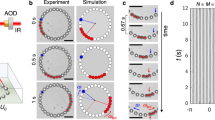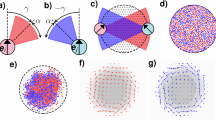Abstract
Condensation of objects into stable clusters occurs naturally in equilibrium1 and driven systems2,3,4,5. It is commonly held that potential interactions6, depletion forces7, or sensing8 are the only mechanisms which can create long-lived compact structures. Here we show that persistent motile structures can form spontaneously from hydrodynamic interactions alone, with no sensing or potential interactions. We study this structure formation in a system of colloidal rollers suspended and translating above a floor, using both experiments and large-scale three-dimensional simulations. In this system, clusters originate from a previously unreported fingering instability, where fingers pinch off from an unstable front to form autonomous ‘critters’, whose size is selected by the height of the particles above the floor. These critters are a stable state of the system, move much faster than individual particles, and quickly respond to a changing drive. With speed and direction set by a rotating magnetic field, these active structures offer interesting possibilities for guided transport, flow generation, and mixing at the microscale.
This is a preview of subscription content, access via your institution
Access options
Subscribe to this journal
Receive 12 print issues and online access
$259.00 per year
only $21.58 per issue
Buy this article
- Purchase on SpringerLink
- Instant access to full article PDF
Prices may be subject to local taxes which are calculated during checkout




Similar content being viewed by others
Change history
10 March 2017
In the version of this Letter orignally published, the Acknowledgements was missing the following sentence: 'We gratefully acknowledge the support of the NVIDIA Corporation with the donation of GPU hardware for performing some of the simulations reported here'. This has been corrected in all versions of this Letter.
References
Anderson, V. J. & Lekkerkerker, H. N. Insights into phase transition kinetics from colloid science. Nature 416, 811–815 (2002).
Aranson, I. S. & Tsimring, L. S. Patterns and collective behavior in granular media: theoretical concepts. Rev. Mod. Phys. 78, 641–692 (2006).
Marchetti, M. et al. Hydrodynamics of soft active matter. Rev. Mod. Phys. 85, 1143–1189 (2013).
Palacci, J., Sacanna, S., Steinberg, A. P., Pine, D. J. & Chaikin, P. M. Living crystals of light-activated colloidal surfers. Science 339, 936–940 (2013).
Bialké, J., Speck, T. & Löwen, H. Active colloidal suspensions: clustering and phase behavior. J. Non-Cryst. Solids 407, 367–375 (2015).
Lu, P. J. & Weitz, D. A. Colloidal particles: crystals, glasses, and gels. Annu. Rev. Condens. Matter Phys. 4, 217–233 (2013).
Schwarz-Linek, J. et al. Phase separation and rotor self-assembly in active particle suspensions. Proc. Natl Acad. Sci. USA 109, 4052–4057 (2012).
Vicsek, T. & Zafeiris, A. Collective motion. Phys. Rep. 517, 71–140 (2012).
Blake, J. & Chwang, A. Fundamental singularities of viscous flow. J. Eng. Math. 8, 23–29 (1974).
Lee, S. & Leal, L. Motion of a sphere in the presence of a plane interface. Part 2. an exact solution in bipolar co-ordinates. J. Fluid Mech. 98, 193–224 (1980).
Huppert, H. E. Flow and instability of a viscous current down a slope. Nature 300, 427–429 (1982).
Chandrasekhar, S. Hydrodynamic and Hydromagnetic Stability (Oxford, 1961).
Sacanna, S., Rossi, L. & Pine, D. J. Magnetic click colloidal assembly. J. Am. Chem. Soc. 134, 6112–6115 (2012).
Bricard, A., Caussin, J.-B., Desreumaux, N., Dauchot, O. & Bartolo, D. Emergence of macroscopic directed motion in populations of motile colloids. Nature 503, 95–98 (2013).
Sing, C. E., Schmid, L., Schneider, M. F., Franke, T. & Alexander-Katz, A. Controlled surface-induced flows from the motion of self-assembled colloidal walkers. Proc. Natl Acad. Sci. USA 107, 535–540 (2010).
Martinez-Pedrero, F., Ortiz-Ambriz, A., Pagonabarraga, I. & Tierno, P. Colloidal microworms propelling via a cooperative hydrodynamic conveyor belt. Phys. Rev. Lett. 115, 138301 (2015).
Grzybowski, B. A., Stone, H. A. & Whitesides, G. M. Dynamic self-assembly of magnetized, millimetre-sized objects rotating at a liquid–air interface. Nature 405, 1033–1036 (2000).
Snezhko, A. Complex collective dynamics of active torque-driven colloids at interfaces. Curr. Opin. Colloid Interface Sci. 21, 65–75 (2016).
Swan, J. W. & Brady, J. F. Simulation of hydrodynamically interacting particles near a no-slip boundary. Phys. Fluids 19, 113306 (2007).
Usabiaga, F. B. et al. Hydrodynamics of suspensions of passive and active rigid particles: a rigid multiblob approach. Preprint at http://arxiv.org/abs/1602.02170 (2016).
Burgers, J. The Nonlinear Diffusion Equation: Asymptotic Solutions and Statistical Problems. Lecture series (Springer, 1974).
Beatus, T., Tlusty, T. & Bar-Ziv, R. Burgers shock waves and sound in a 2D microfluidic droplets ensemble. Phys. Rev. Lett. 103, 114502 (2009).
Desreumaux, N., Caussin, J.-B., Jeanneret, R., Lauga, E. & Bartolo, D. Hydrodynamic fluctuations in confined particle-laden fluids. Phys. Rev. Lett. 111, 118301 (2013).
Goodman, J. & Miller, J. R. Long-time behavior of scalar viscous shock fronts in two dimensions. J. Dyn. Differ. Equ. 11, 255–277 (1999).
Pouliquen, O., Delour, J. & Savage, S. Fingering in granular flows. Nature 386, 816–817 (1997).
Pan, T., Joseph, D. & Glowinski, R. Modelling Rayleigh–Taylor instability of a sedimenting suspension of several thousand circular particles in a direct numerical simulation. J. Fluid Mech. 434, 23–37 (2001).
Lin, T., Rubinstein, S. M., Korchev, A. & Weitz, D. A. Pattern formation of charged particles in an electric field. Langmuir 30, 12119–12123 (2014).
Wysocki, A. et al. Direct observation of hydrodynamic instabilities in a driven non-uniform colloidal dispersion. Soft Matter 5, 1340–1344 (2009).
Metzger, B., Nicolas, M. & Guazzelli, E. Falling clouds of particles in viscous fluids. J. Fluid Mech. 580, 283–301 (2007).
Löwen, H. Particle-resolved instabilities in colloidal dispersions. Soft Matter 6, 3133–3142 (2010).
Guazzelli, E. & Hinch, J. Fluctuations and instability in sedimentation. Annu. Rev. Fluid Mech. 43, 97–116 (2011).
Allan, D., Caswell, T., Keim, N. & van der Wel, C. trackpy: Trackpy v0.3.2 [Data set]. Zenodo. https://doi.org/10.5281/zenodo.60550 (2016).
Acknowledgements
This work was supported primarily by the Gordon and Betty Moore Foundation through Grant GBMF3849 and the Materials Research Science and Engineering Center (MRSEC) program of the National Science Foundation under Award Number DMR-1420073. A. Donev and B. Delmotte were supported in part by the National Science Foundation under award DMS-1418706. P. Chaikin was partially supported by NASA under Grant Number NNX13AR67G. We gratefully acknowledge the support of the NVIDIA Corporation with the donation of GPU hardware for performing some of the simulations reported here.
Author information
Authors and Affiliations
Contributions
M.D. performed the experiments. B.D. performed the simulations. M.Y. and S.S. synthesized the colloidal particles. M.D., B.D., A.D. and P.C. conceived the project, analysed the results and wrote the paper.
Corresponding authors
Ethics declarations
Competing interests
The authors declare no competing financial interests.
Supplementary information
Supplementary information
Supplementary information (PDF 1332 kb)
Supplementary Movie 1
Supplementary Movie (AVI 4730 kb)
Supplementary Movie 2
Supplementary Movie (AVI 4299 kb)
Supplementary Movie 3
Supplementary Movie (AVI 4778 kb)
Supplementary Movie 4
Supplementary Movie (AVI 4449 kb)
Supplementary Movie 5
Supplementary Movie (AVI 3385 kb)
Supplementary Movie 6
Supplementary Movie (AVI 4873 kb)
Supplementary Movie 7
Supplementary Movie (AVI 4638 kb)
Supplementary Movie 8
Supplementary Movie (AVI 4765 kb)
Supplementary Movie 9
Supplementary Movie (AVI 4686 kb)
Rights and permissions
About this article
Cite this article
Driscoll, M., Delmotte, B., Youssef, M. et al. Unstable fronts and motile structures formed by microrollers. Nature Phys 13, 375–379 (2017). https://doi.org/10.1038/nphys3970
Received:
Accepted:
Published:
Issue date:
DOI: https://doi.org/10.1038/nphys3970
This article is cited by
-
Self-propulsion, flocking and chiral active phases from particles spinning at intermediate Reynolds numbers
Nature Physics (2025)
-
A method of fundamental solutions for large-scale 3D elastance and mobility problems
Advances in Computational Mathematics (2025)
-
The mismatch between experimental and computational fluid dynamics analyses for magnetic surface microrollers
Scientific Reports (2023)
-
Microrollers flow uphill as granular media
Nature Communications (2023)
-
Spontaneous shock waves in pulse-stimulated flocks of Quincke rollers
Nature Communications (2023)



